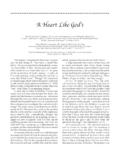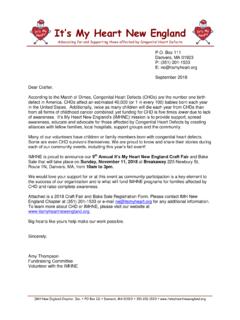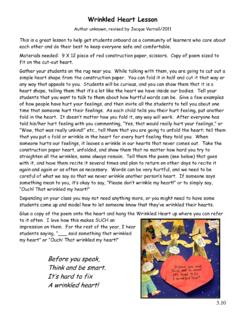Transcription of Surgical Procedures - Children's Heart Foundation
1 Surgical ProceduresSurgical Procedures For Treatment of Congenitaland Acquired Heart DefectsCardiovascular Surgical Procedures or operations may have one of several correctiveprocedures are required to make Heart structures correctiveprocedures are required to separate and/or redi-rect the blue and pink blood circulations. These corrective Procedures range fromthe relatively simple, such as closing or patching a hole or tying off a vessel, to thecomplex, such as switching vessels or rerouting blood streams. Most correctiveoperations require the use of a Heart -lung machine, a cardio-pulmonary bypasspump.
2 Some corrective Surgical Procedures provide complete correction of thenormal physiology of the Heart . Some corrective Procedures provide an altered typeof physiology of the Heart and provide permanent palliation, such as the Fontan proceduresare required to improve, but not correct, an abnormal heartfunction. Palliative operations are performed to improve the Heart function, usuallyin children too young for corrective surgery. The aim is to lessen cyanosis, to con-trol Heart failure, or to prepare the circulation for later Heart operations are truly corrective; usually some lifetime follow up is surgeries can restore the Heart and vessels to near normal performance andextend the life operations require the chest to be opened under general approach is either through the midline of the chest, called a median sternoto-my,or from either side of the chest, called a lateral thoracotomy.
3 Minimally invasiveheart surgery using small incisions is gaining popularity and doctors are hopeful thatendoscopic surgery will soon be available for some cardiac defects. Endoscopic sur-gery uses a viewing tube to examine and treat internal structures without openingthe body s My Hear tChapter SixArterial SwitchThe Arterial Switch is the preferred anatomically corrective operation for both sim-ple and complex forms of d-transposition of the great arteries because it restoresthe structure and the function of the Heart to normal. The aorta and pulmonaryartery are severed from their transposed origins and reconnected in such a way thatthey receive the correct blood from the correct ventricle.
4 That is, after repair, the LVdirects blood to the aorta and the RV sends blood to the LV. The arterial switchrequires a separate transfer of the coronary arteries from the originally right-sidedaortic stump to the new left-sided aortic root, the former pulmonary of the better-known Heart operations are described below for quick refer-ence. (See chapter on Congenital Heart Defects for the currently recommendedsurgical procedure appropriate to a specific defect.)It s My Hear tSurgical Procedures106 Postoperative Arterial Switch Repair of Transposition of the Great ArteriesThe Blalock-Hanlon Procedure (Creation of an Atrial Septal Defect) This is a closed- Heart operation aimed at improving the bluish cyanosis color in cer-tain conditions such as transposition or tricuspid atresia.
5 While complete separationof blue and pink circulations is normally desirable, in transposition and several otheranomalies, the two circulations must mix within the Heart for the child to do well. Ahole in the atrial septum is an efficient way to accomplish such mixing. Eventually,anatomic or physiologic repair will Blalock-Taussig or BT Shunt Shunts are Surgical connections, or anastomoses, between two arteries or betweena vein and an artery. The Blalock-Taussig shunt connects a branch of the aorta, usu-ally the subclavian artery, to the pulmonary artery directly or by using a plastic tubeto increase the pulmonary blood s My Hear tSurgical ProceduresPostoperative Subclavian Arteryto Pulmonary Artery Anastomosis (Blalock-Taussig Shunt) for Tetralogy of FallotClosure of Septal Defects Smaller atrial and ventricular septal defects can be closed with sutures or defects require the use of a plastic patch.
6 Occasionally, in complex defects,the patch is used not only to close the hole between the ventricles but also to chan-nel left ventricular blood through the right ventricle into the aorta through an intrac-ardiac s My Hear tSurgical Procedures108 Postoperative Patch Repair of VentricularSeptal DefectCorrection of Narrow Valves The four valves in the Heart can be narrow, stenosed, or regurgitant, leaky, or can be either repaired or replaced, depending on the nature of the most common aortic and pulmonic stenosis is caused by congenital fusion ofone or more moving valve leaflets. Repair is done using cardiopulmonary bypass andby cutting the fused leaflets apart.
7 Occasionally, however, the seat of the valve, theannulus, is small, a condition called hypoplastic. Enlargement of the pulmonic annu-lus is accomplished by cutting it and placing a trans-annular patch across it. Theresulting valve leak is usually well tolerated for a decade or more. A small aorticannulus cannot be enlarged without valve replacement because it would causeexcessive regurgitation, or leaking. A regurgitant aortic valve can sometimes berepaired by tightening the loose leaflets in a procedure called a valvuloplasty). Narrowmitral or tricuspid valves can rarely be enlarged and usually need to be mitral or tricuspid valves can frequently be repaired by can be replaced by biological or prosthetic material.
8 Biological valves areeither homograft, taken from a human cadaver donor, or porcine, taken from a is a variety of prosthetic valves available. Many issues need to be consideredwhen choosing the most suitable valve. Mechanical prosthetic valves will require alifetime of clot-preventing medication, such as Coumadin or aspirin, and may not beideal for females desiring to become pregnant. At this writing, an ideal valve has notyet been designed and most prosthetic valves will eventually need s My Hear tSurgical ProceduresDamus-Kaye-Stansel OperationThis procedure usually complements other corrective Procedures .
9 It was originally developed along with the Rastelli procedure for correcting transposed great arter-ies with a VSD without switching them. It is now frequently employed as part of theFontan operation in one-ventricle repairs to overcome any obstruction to the aor-tic blood flow. It consists of connecting the pulmonary trunk and the ascendingaorta, and detaching the pulmonary artery branches. The pulmonary artery branch-es are supplied temporarily by an artificial shunt from the aortic branches. The aortathus receives flow through both pulmonic and aortic s My Hear tSurgical Procedures110 Postoperative main pulmonary artery toascending aorta (end-to-side) anastomosiswith patch closure of aortic orifice (Damus-Kaye-Stansel operation) and conduit interposition from right ventricle todistal pulmonary artery (Rastelli repair) for:Transposition of the Great Arteries withValvular and Subvalvular Aortic Stenosis Postoperative Patch Closure of VentricularSeptal DefectFontan Operations Many versions of this physiologically corrective procedure exist and they continuebeing updated.
10 The Fontan operation is reserved for complex Heart abnormalitiesthat cannot undergo two-ventricle repair. Such hearts are grouped together as uni-ventricular, meaning that there is only one functional ventricle, which must be left topropel the pink blood to the body. The blue and pink circulations are surgically sep-arated by atrial partition and the blue side the IVC, inferior vena cava and SVC,superior vena cava is connected directly to the pulmonary artery without anyvalves. There is no pump for the blue blood, but the circulation is nevertheless effec-tive as long as the pressure in the lungs are low.









